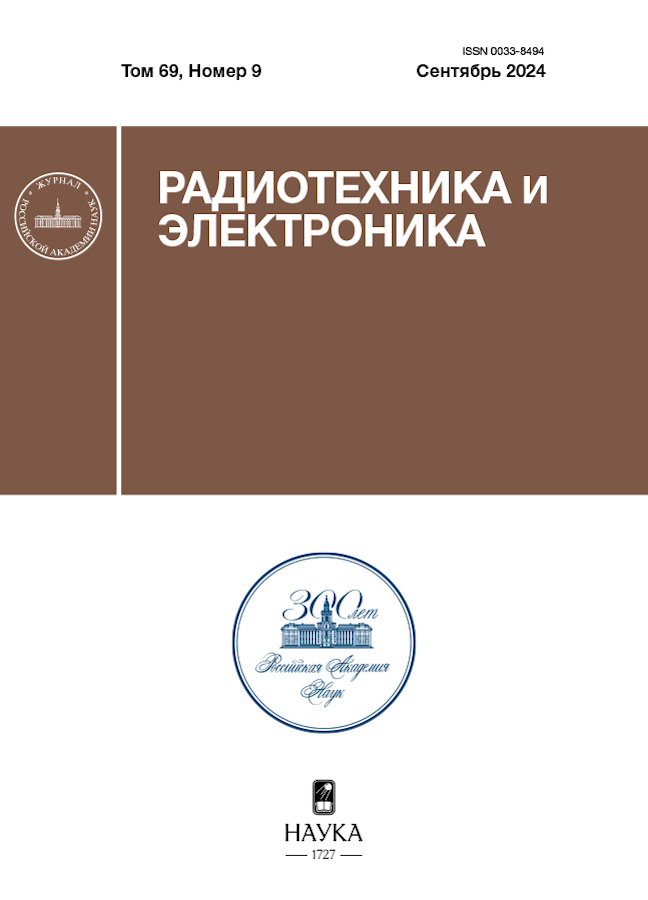Класс весовых функций с плоской вершиной и низкими боковыми лепестками спектра для гармонического анализа сигналов
- Авторы: Зайцев Г.В.1, Хзмалян А.Д.1
-
Учреждения:
- ПАО НПО «Алмаз» им. акад. А.А. Расплетина
- Выпуск: Том 69, № 9 (2024)
- Страницы: 866-877
- Раздел: ТЕОРИЯ И МЕТОДЫ ОБРАБОТКИ СИГНАЛОВ
- URL: https://edgccjournal.org/0033-8494/article/view/683528
- DOI: https://doi.org/10.31857/S0033849424090068
- EDN: https://elibrary.ru/HRMQRB
- ID: 683528
Цитировать
Полный текст
Аннотация
Рассмотрены весовые функции с плоской вершиной, используемые для повышения точности измерения амплитуды составляющих спектра при дискретном гармоническом анализе. Предложен новый класс весовых функций с плоской вершиной, обеспечивающих минимальный уровень максимального бокового лепестка спектра и простой способ вычисления значений функции. Описаны математическое представление новых весовых функций и метод оптимизации их параметров, основанные на предыдущих работах авторов. Синтезирован ряд весовых функций с плоской вершиной порядков 1…6 со скоростями спада боковых лепестков 6, 12, 18, 24, 30, 36 и 48 дБ/окт, представлены таблицы их параметров и проанализированы характеристики синтезированных функций. Предложен альтернативный способ повышения точности измерения амплитуды спектральных составляющих.
Полный текст
Об авторах
Г. В. Зайцев
ПАО НПО «Алмаз» им. акад. А.А. Расплетина
Автор, ответственный за переписку.
Email: gennady-zaytsev@yandex.ru
Россия, Ленинградский просп., 80, корп. 16, Москва, 125190
А. Д. Хзмалян
ПАО НПО «Алмаз» им. акад. А.А. Расплетина
Email: gennady-zaytsev@yandex.ru
Россия, Ленинградский просп., 80, корп. 16, Москва, 125190
Список литературы
- Хэррис Ф.Дж. // ТИИЭР. 1978. Т. 66. № 1. С. 60.
- Prabhu K.M.M. Window Functions and Their Applications in Signal Processing. Boca Raton: CRC Press, 2014.
- Оппенгейм А.В., Шафер Р.В. Цифровая обработка сигналов. М.: Техносфера, 2006.
- D’Antona G., Ferrero A. Digital Signal Processing for Measurement Systems. N.Y.: Springer Media, 2006.
- Salvatore, L., Trotta A. // IEE Proc. 1988. V. 135. № 6. P. 346.
- Heinzel G., Rudiger A., Schilling R. Spectrum and Spectral Density Estimation by the Discrete Fourier transform (DFT), Including a Comprehensive List of Window Functions and Some New at-top Windows. Hannover: Max-Planck-Institut fur Gravitationsphysik, Teilinstitut. 2002, 84 p.
- Cortés C.A., Mombello E., Dib R., Ratta G. // Signal Processing. 2007. V. 87. P. 2151.
- Зайцев Г.В. // Радиотехника. 2011. № 3. С. 21.
- Коллатц Л., Крабс В. Теория приближений. Чебышевские приближения и их приложения. М.: Наука, 1978.
- Зайцев Г.В. // Радиотехника. 2012. № 1. С. 55.
- Хзмалян А.Д. // Вестник воздушно-космической обороны. 2018. № 4. С. 90.
- Zaytsev G.V., Khzmalyan A.D. // Proc. Int. Conf. on Eng. and Telecom. (EnT). Dolgoprudny. 20–21 Nov. 2019. N.Y.: IEEE, 2019. https://doi.org/10.1109/EnT47717.2019.9030552
- Зайцев Г.В., Хзмалян А.Д. // РЭ. 2021. Т. 66. № 5. С. 443. https://doi.org/10.31857/S0033849421050120
- Зайцев Г.В., Хзмалян А.Д. Оптимальные весовые функции для гармонического анализа сигналов в реальном времени. М.: НПО «Алмаз», 2023. https://elibrary.ru/item.asp?id=54363389
Дополнительные файлы














